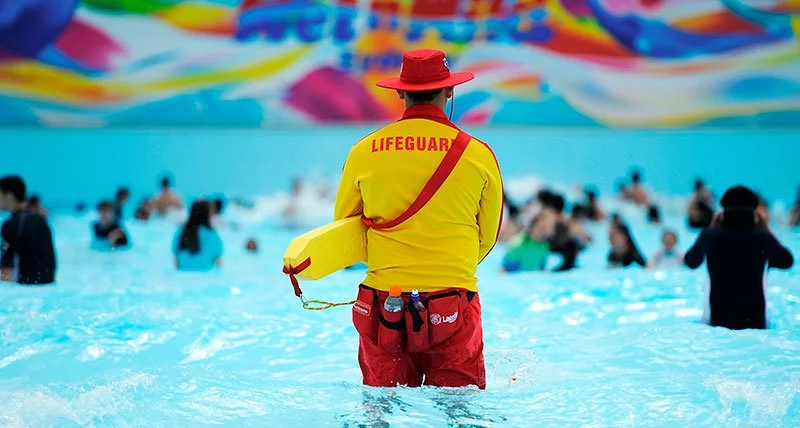Ensuring Safety at Aquatic Facilities: A Guide to Risk Prevention
By PAGE Editor
Aquatic facilities provide a space for entertainment, fitness, and recreation, yet they also accompany innate risks and dangers. Whether it's a community pool, waterpark, or public beach, the responsibility for ensuring safety falls on the shoulders of facility operators, lifeguards, and patrons the same.
To relieve risks, proactive measures should be carried out to establish a solid environment for everybody. This article investigates effective strategies to prevent dangers at aquatic facilities.
Understanding Normal Risks at Aquatic Facilities
To prevent dangers, it's crucial to first identify the most well-known risks at aquatic facilities. These include:
Drowning and Near-Drowning Incidents: Perhaps of the most serious risk, frequently brought about by an absence of supervision, inadequate swimming skills, or medical emergencies.
Slip-and-Fall Accidents: Wet surfaces around pool decks and changing rooms make a high risk of injuries.
Chemical Exposure: Improper handling or imbalance of pool chemicals like chlorine can prompt respiratory issues, skin aggravation, or water contamination.
Heat-Related Illnesses: Outdoor facilities open patrons to sunburns, dehydration, and heatstroke.
Overcrowding: A pressed facility makes it harder for lifeguards to monitor activities, expanding the risk of accidents.
By perceiving these hazards, aquatic facility supervisors can all the more likely prepare and carry out strategies to minimize risks.
Staff Training and Professional Lifeguarding
Properly trained staffs are the foundation of a safe aquatic facility. Lifeguards play a vital role in monitoring swimmers, preventing accidents, and responding to emergencies. Ensuring your lifeguards hold a substantial American lifeguard certification ensures they are equipped with the skills expected to perform rescues, control CPR, and handle other basic situations.
Ongoing Training: Lifeguards should participate in regular supplemental classes to remain refreshed on new safety protocols and keep up with peak performance.
In-Service Drills: Directing reproduced emergencies can prepare the staff to answer unhesitatingly under pressure.
Team Communication: Lifeguards should be helped effective communication techniques to arrange with each other and notify facility administrators of potential hazards.
Establishing Clear Safety Rules and Policies
Clear and enforceable rules are a non-debatable component of risk prevention. Patrons frequently underestimate the potential dangers of aquatic environments, so it's the facility's responsibility to educate and guide them.
Signage: Introduce apparent and straightforward safety signs all through the facility. These should remember admonitions about running for wet surfaces, making a plunge shallow areas, and restricted zones for non-swimmers.
Entry Protocols: Uphold rules in regards to mature or skill-proper admittance to specific areas, like profound water pools or slides.
Supervision Requirements: Expect that children are constantly accompanied by a grown-up, and clarify rules about buoyancy devices.
By fostering a culture of consistence and responsibility, aquatic facilities can significantly decrease risks.
Facility Upkeep and Inspections
An inadequately kept up with facility is a favorable place for accidents. Regular inspections and upkeep schedules should be a main concern to ensure all equipment and framework satisfy safety guidelines.
Pool Decks and Surroundings: Keep surfaces perfect, dry, and liberated from hindrances to prevent slip-and-fall incidents. Use non-slip materials where possible.
Water Quality: Monitor and keep up with proper chemical levels to prevent contamination and ensure clear visibility for lifeguards.
Safety Equipment: Ensure all rescue tools, for example, life floats, spine sheets, and automated external defibrillators (AEDs), are promptly accessible and in working request.
Structural Integrity: Direct regular checks of jumping sheets, slides, and stepping stools to ensure they stay durable and secure.
Proactive support prevents accidents as well as fosters trust among patrons who depend on the facility for their safety.
Emergency Preparedness
While prevention is a definitive objective, accidents can in any case happen. A strong emergency response plan is essential to moderate the impact of such incidents.
Emergency Action Plans (EAPs): Each facility should have a well-reported and practiced plan for handling different emergencies, including medical emergencies, chemical spills, and natural catastrophes.
First Aid Stations: Ensure that first aid supplies are completely loaded and effectively available. Lifeguards should be trained to effectively utilize these provisions.
Communication Systems: Introduce dependable communication systems, like whistles, radios, and public address systems, to work with quick response during emergencies.
A well-prepared team can save lives and minimize injuries, even in the most startling situations.
Promoting Education and Awareness Among Patrons
Education is a powerful device in risk prevention. Patrons who know about potential dangers are more prone to mindfully act.
Swim Lessons: Offer swimming classes to show patrons water safety and improve their skills. This is especially significant for children and inexperienced swimmers.
Safety Campaigns: Use banners, online entertainment, and declarations to advance awareness about sun protection, hydration, and safe swimming practices.
Orientation Sessions: Provide new guests with a concise overview of the facility's rules and emergency systems.
Drawing in patrons in safety efforts establishes a collaborative environment where everybody contributes to reducing risks.
Special Considerations for High-Risk Groups
Certain groups, like children, the older, and individuals with medical conditions, are more weak in aquatic environments. Facilities should play it safe to protect these patrons.
Designated Zones: Make separate areas for children and beginners to decrease the probability of accidents.
Accessibility: Ensure the facility is equipped with inclines, lifts, and other facilities for individuals with disabilities.
Supervised Activities: Offer supervised programs for high-risk groups to provide extra oversight.
These measures help ensure that all patrons, no matter what their age or capacity, can enjoy the facility safely.
Collaborating with the American Lifeguard Association
The American Lifeguard Association (ALA) plays a basic role in promoting water safety and giving top-level lifeguard certification to lifeguards. Partnering with the ALA can enhance the safety protocols at your facility by ensuring that your team approaches the most recent resources, certifications, and best practices.
The ALA's programs focus on outfitting lifeguards with the knowledge and skills important to prevent accidents and answer effectively in emergencies. By adjusting your facility's safety measures with the ALA's standards, you show a commitment to excellence and build trust inside your community.
Final Word
Preventing risks and dangers at aquatic facilities requires a diverse methodology that incorporates staff training, clear safety rules, facility upkeep, and supporter education. By focusing on safety and collaborating with organizations like the American Lifeguard Association, facility operators can establish a solid and enjoyable environment for everybody.
When proactive measures are taken, aquatic facilities can offer the perfect blend of fun, fitness, and relaxation — without settling for less on safety.
HOW DO YOU FEEL ABOUT FASHION?
COMMENT OR TAKE OUR PAGE READER SURVEY
Featured








Riding an electric bike comes with a unique set of challenges, particularly when it comes to braking.